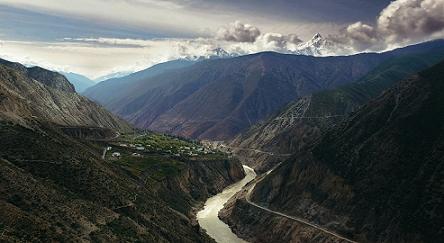By Jim Boyce | Vineyards so far south that the Tropic of Cancer cuts through them, at lofty elevations associated more with skiing than grapes, in isolated terrain where one misstep might mean falling off a steep cliff. Yunnan might not seem the most obvious place to make quality wine but this southwest China province has been turning heads.
Roughly equal to Switzerland in size and Spain in population, Yunnan borders Laos, Myanmar and Vietnam and is well-known for its agricultural products, including tea and coffee. Its wines are now poised to jump into the spotlight, starting in two weeks when Moet Hennessy launches its label Ao Yun at VinExpo in Hong Kong. This Bordeaux-style blend use grapes grown at 2500 to 2700 meters, near the town of Shangri-la, and already has kudos from critics such as Jancis Robinson, Jane Anson, Jasper Morris and Elin McCoy to its credit. It isn’t cheap–a bottle is reportedly USD250 / CNY1500–but will help give exposure to Yunnan’s wine region as a whole.
And this is, indeed, an intriguing region. Not only because its wines have been showing promise for years, but also due to the the extreme and unique locations of its vineyards and wineries, to a history that includes 19th-century European missionaries who came bearing vines, and to the use of hybrid varieties that disappeared long ago in Europe. You can add that the province offers a wealth of food, drink and sightseeing opportunities. And, in terms of viticulture, Yunnan has a major advantage over bigger and better-known regions to the north, namely, it doesn’t have to do the costly and damaging process of covering its vines each fall to protect them against the winter cold.
I recently covered all this and more in a 2500-word story for magazine Wine Business International–click here for the pdf–with comments from experts like Ma Huiqin, Yang Huafeng, Shan Shumin, Jean-Guillaume Prats, David Tyney and Kelly Pearson.
To be sure, the Yunnan wine scene is a work in progress, and the province lacks the large accessible tracts of vineyards found in other regions. Then again, perhaps that might push it toward a worthy niche, namely, that it can become a low-volume high-quality producer versus the bigger wine scenes in places like Ningxia, Hebei and Shandong, the Grand Cru or Grand “Crunnan” (drum roll) to their general Bordeaux.
The full story is here. You can learn more about Wine Business International here.
Get the free Grape Wall e-newsletter by signing up below.
Grape Wall has no sponsors of advertisers: if you find the content and projects like World Marselan Day worthwhile, please help cover the costs via PayPal, WeChat or Alipay.
Sign up for the free Grape Wall newsletter here. Follow Grape Wall on LinkedIn, Instagram, Facebook and Twitter. And contact Grape Wall via grapewallofchina (at) gmail.com.
